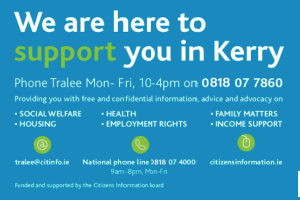 THE Diocese of Kerry has issued extensive guidelines for churches and parishioners, as Masses are set to return in the coming weeks.
THE Diocese of Kerry has issued extensive guidelines for churches and parishioners, as Masses are set to return in the coming weeks.
The guidelines are designed to assist parishes in making the necessary preparations to ensure that the church is ready to welcome parishioners for the celebration of public Mass.
The updated public health guidelines from the Government allow indoor public gatherings of up to 50 people from June 29 and this will rise to 100 people indoors after July 20.
Continued below…
Among the many new measures are that parishioners may have to reserve a time to attend Mass, hand sanitisers are required at all church entrance and exit doors, holy water fonts will be empty and priests and Liturgical ministers will wear a visor while giving holy communion (which will always be received by massgoers in their hands, not mouths).
The key preparations for churches t0 host Masses in the Diocese include:
• Setting the capacity of the church, based on current social distancing requirements
• Encouraging people to attend any Mass during the week, not necessarily Sunday Mass
• A Covid-19 response plan in each parish
• A Parish Support Team in place to ensure the implementation of these guidelines
• The Appointment of a member of the support team as the Covid-19 Safety Officer
Putting in place a Cleaning Team for the regular cleaning of the church as per the guidelines
• Each volunteer or liturgical Minister should be furnished with the guidelines issued to parish employees when Parish Offices were re-opened and parish employees returned to work: Return to Work Guidelines
• All volunteers and liturgical Ministers sign the Return to Work Form,
• Identifying An Isolation Area in the event an employee, volunteer or Mass-goer takes ill with Covid-19 symptoms
There is an extensive list of protocols regarding the reopening listed in a document available on the Diocese of Kerry website. It can be accessed by clicking on this link or by reading the full document below…
PREPARATIONS FOR THE RETURN OF PUBLIC MASS
- The purpose of this document is to enable as many people as possible to participate in the celebration of the Eucharist on a weekly basis, not necessarily Sunday notwithstanding the limitations as a result of Covid-19.
- The dispensation from attending Mass on Sundays and Holydays of obligation remains in place until further notice. People are encouraged to attend Mass on any day during the week. In this way, it is hoped that parishioners, who would have normally attended Mass on a Saturday night or Sunday morning pre Covid-19, can be accommodated at the Masses throughout the week taking into account the reduced capacity of the church.
- Any person with an underlying medical condition or at high risk of severe illness as a result of Covid-19 should be advised to stay at home and to continue participating in the Mass online or by radio link. Any elderly person who does not yet feel ready to return to the public celebration of Mass, should also be advised that they may remain at home and participate in the Mass online or hear the Mass through the Parish radio link.
GETTING THE PARISH READY FOR PUBLIC MASS
- Each Parish in consultation with the Parish Pastoral Council shall establish a Covid-19 Support Team to oversee the implementation of the Diocesan Guidelines and ensure that the parish church/churches are prepared in a manner which will facilitate all to return safely to the celebration of Mass.
- Each parish shall develop a Covid-19 response plan as set out in the Return to Work Safely Protocol.
- A checklist for parishes is provided at Appendix 3.
CREATING A SAFE PLACE TO WORSHIP
Carry out an assessment of each church within the parish and determine the maximum number of people who will be able to attend Mass at any one time bearing in mind the current rules in relation to social distancing which requires that people should maintain physical distance from each other of at least 2 metres (6 feet).
-
- Consider the creation of a family section within the church where members of the one family (more than two) can sit together for Mass. Members of a family who reside together do not need to observe social distancing, but must of course remain socially distant from other members of the congregation.
- Have a plan in place to accommodate people with a disability and their carer/support person so they can attend Mass safely and ensure optimum participation.
- In parishes where there is more than one church, consideration should be given to celebrating all Masses in the largest church initially, which would allow for greater numbers to attend and would help in maintaining hygiene. Masses could be celebrated in the other churches of the parish at a later stage.
- Parishes should work with other parishes within the Pastoral Area to agree a schedule of Mass times which will facilitate the greatest number of people in attending Mass at least weekly.
- Parishes should operate within the existing number of Masses per week and should not schedule additional masses.
- The health and wellbeing of our Priests is very important and they must continue to take their days off. It may be necessary for a parish to reduce the number of weekly masses.
ENABLING PEOPLE TO PARTICIPATE AT MASS
- Once each parish has determined the maximum number of people that can attend at Mass the parish must then decide on how to facilitate the attendance at Mass. It is preferable that people are notified in advance of how this will be done so as to avoid a situation whereby people are turned away.
- Parishes might consider the following:
- People will reserve a time to attend Mass weekly. This can be done through the Parish Office. Consider putting in place a dedicated phone number to facilitate this process. Parishes can consider other ways to do this such as online or the creation of an app. (Bear in
mind that there will be parishioners who will feel uncomfortable or may not be able to use the internet or social media).
- Designate specific Mass times for station areas, particular townlands, town districts/streets/housing estates. This can be done on a rota basis which would allow the opportunity for people to be able to attend a Mass on a Sunday every few weeks.
- Consider the transfer of a daily morning Mass to an evening to facilitate workers.
- Consider designating a weekly Mass for elderly parishioners and their carers.
- Parishes should take into account the impact on capacity arising from anniversary Masses etc. Consider spreading these Masses throughout the week and perhaps limiting the number of such anniversaries at any one Mass. Ascertain in advance how many family members will be attending the anniversary Mass.
- Request those who have reserved a place at a specific Mass, who are now unable to attend to let the parish know. (This is where a dedicated phone number is beneficial and the phone number can be contacted on the day of the Mass).
- Parishes must not allow people to attend Mass or to cater for any overflow of people on church grounds outside the church at the present time. The Government advice presently is that groups of up to 6 people who are not from the same household can meet outdoors. Any large gathering outside the church would therefore be in breach of Government guidelines.
SANITISATION and HYGIENE
In the church
- Each parish should establish a cleaning team to ensure that the church is cleaned in advance of the return of public Mass and then to ensure that the church is cleaned after every gathering. The members of the cleaning team must wear a face covering and gloves at all times when cleaning the church.
- Each church and sacristy must have in place appropriate hand hygiene facilities and hand sanitiser in place and display posters in relation to hand hygiene, cough etiquette and Covid-19.
- There must be hand sanitisers or dispensers for sanitising gel at all church entrance and exit doors, at the entrance to and exit from the sacristy as well as in the sacristy itself and at the entrance to the toilet and in the toilet itself. Where dispensers are in use ensure that they are regularly topped up and checked in advance of each Mass.
- Holy Water fonts are to remain empty and should be covered, until further notice.
- Where church toilets are in use, the toilets will have to be cleaned after every use.
In the Sacristy
- Remember that the sacristy is also a place of work. The appropriate notices in relation to hand hygiene, cough etiquette and Covid-19 must be displayed. The sacristan must be provided with essential cleaning materials to keep the sacristy clean, such as wipes, paper towels and disinfection products. The sacristan should be provided with tissues and a separate bin for disposal. The bin to be emptied regularly. The sacristy should be cleaned after each Mass.
- Care should be taken to see that communion hosts are covered at all times. Make sure that hands are properly sanitized before the communion hosts are transferred carefully to a covered ciborium in preparation for Mass. This will reduce the risk of the communion hosts being contaminated.
MINISTERS/VOLUNTEERS
- Liturgical ministers or volunteers should not feel under pressure to return to public ministry or to a volunteering role. Where a volunteer or liturgical minister wishes to return to public ministry or a volunteering role, they should be advised of the new protocols.
- Some ministers/volunteers are over the age of 70. The Government advice is that people over the age of 70 have the right to exercise their own judgement as to what extent they consider the cocooning guidance to be appropriate to them. The advice is clear that where a person over the age of 70 has an underlying medical condition or is at very high risk of severe illness as a result of Covid-19 then they should follow the cocooning measures in order to keep themselves safe.
- A contact log must be maintained by each parish containing the names and telephone numbers of all volunteers involved in the Mass and those involved in the Liturgy. This is to facilitate contact tracing in accordance with Government requirements. Note the Return to Work Safely Protocol published by the Government applies to all Parishes.
- Each new usher, volunteer, liturgical minister etc. must complete the Return to Work Form. There is no requirement that the completion of the form be repeated by every individual at every Mass. The responsibility falls to each individual to notify the PP/Parish Office if there has been any material change to the information already provided. Where a person has been on an extended absence or on holidays or is part of a rota system within the parish, it is good practice that the person sign a fresh Return to Work Form on their return to parish duty.
- Access to the sacristy should be limited to the sacristan, the priest, concelebrating clergy or deacon. There should be no unauthorized access to the sacristy. A contact log must be maintained in the sacristy. The rules of social distancing apply to the sacristy. A maximum capacity should be established for the sacristy and all people using the sacristy must keep their physical distance from each other.
- Parishes should supply visors for all those playing an active role in the Mass. Parishes should consider if each person should have their own visor and be responsible for its sanitisation and ensure they bring their visor to each Mass in which they are involved. The alternative is that the parish retains the visors and ensures that they are fully sanitised after each Mass prior to making them available for future use. In the case of the former consider having some spare visors available where someone arrives without their visor or arrives with a damaged visor.
- All sacristans, volunteers, liturgical ministers, ushers etc. should be provided with training re Covid-19 protocols prior to taking up their roles.
- In advance of each Mass, prepare a list of all people who will be engaged in the Mass such as Ushers, Readers, Ministers of the Eucharistic, Collectors, Cantor, Musician, Cleaning Team, any other liturgical ministers or volunteers. Remember the parish has a responsibility to all volunteers and those involved in the Liturgy and all persons involved must complete a Covid-19 return to work form. A sample form is attached at Appendix 2
ROLE OF THE USHER AT PUBLIC MASSES
- The usher is there to assist and offer support and to encourage compliance with the guidelines.
- Ushers should wear an armband marked accordingly to show that they are part of the support team. This is preferable to the wearing of a high visibility jacket.
- Ushers should be at the church at least 40 minutes prior to the start of Mass to facilitate entrance, ensure that the maximum capacity is not exceeded, to guide people to their seats, to guide people during the distribution of Holy Communion and to guide people on leaving the church.
- In order to ensure that maximum capacity is not exceeded it is recommended that entrance to the church be via the main entrance doors. This will facilitate the ushers in managing numbers. Additional entrances should not be used. Parishioners should be encouraged to attend early and to be in their seats no later than 5 minutes before the Mass is due to start.
- If people arrive at Mass without reserving a time explain the position to them in a polite and courteous manner. They can be asked to wait outside to see if vacancies arise and where this does happen, they can be directed to available seats. (It is likely that cases will arise where people will reserve a Mass time and then for whatever reason will not attend).
- Within the church, the usher keeps the movement of people to a minimum and in so far as is possible have a one-way system in place and keeping crossover or pinch points to a minimum. It is appreciated that each church layout is different and it will be a matter for each parish to devise a way of facilitating this taking account of the individual church layout.
- The ushers shall assist the congregation in approaching the Communion Station by ensuring a direct one-way movement and making sure that all communicants maintain physical distance from each other. Appropriate markings should be marked on the floor to facilitate physical distancing. Consider asking the communicants to approach Holy Communion pew by pew and in churches with a narrow aisle put in place a system which allows communicants to approach the Communion Station on one side and return to their seat on the other side. Try and minimize the crossing over of people where possible.
- At the end of Mass have a number of exit points where possible and request people to leave in an orderly manner pew by pew and obeying the directions of the ushers.
CELEBRATING PUBLIC MASSES
The Diocesan recommendation is that all taking particular roles at Mass would wear a transparent visor which helps people who do not know that they have the virus from spreading it to others. It also allows for immediate recognition.
It is important that the celebration of the Eucharist be a joyful and uplifting experience, notwithstanding the limitations being imposed as a result of Covid-19.
- Parishioners attending Mass should wear a face covering in church. (Note that face coverings are not suitable for children under the age of 13 and that not everyone will feel comfortable wearing a face covering. While the wearing of a face covering is recommended it is not mandatory).
- Liturgical ministers and those involved in the liturgy should be in their places prior to the start of Mass. They must observe social distancing.
- A simple entrance and recessional procession is recommended at the present time.
- The congregation shall be asked to sit and stand as appropriate during Mass. The congregation shall be requested not to kneel. Consideration should be given to making an announcement at the start of Mass pointing out the new requirements and thanking people for their cooperation.
- Concelebration should be limited and concelebrants should receive Holy Communion under both species using separate chalices or by intinction.
- Readers are recommended to wear a visor when proclaiming the word of God. Readers should read from a separate microphone.
- Altar servers will not be permitted to exercise their ministry until further notice.
- Music may be provided by a cantor or instrumentalist, provided they maintain social distance. Since congregational singing is not recommended at this time, the cantor may consider music that would be otherwise unfamiliar to the congregation. Choirs are not permitted to exercise their ministry at this time.
- Missalettes should not be used at Mass until further notice. A newsletter may be made available for collection at the exit points when the congregation is leaving the church.
- At the Sign of Peace, invite the congregation to indicate their prayer for the other’s peace, by a wave, nod or other gesture while remaining socially distanced.
- Place a box at the entrance/exit points of the Church for the collection of envelopes/cash offerings/offertory collection. Request people to drop their offerings into these boxes reminding them that they can also make a donation online, by standing order/direct debit or by dropping their offerings into the Parish Office. These boxes should be supervised at all times during Mass.
- After Mass, remind the ushers/volunteers/liturgical ministers etc. to sanitise their visor. Where the parish is retaining the visors these must be sanitized immediately after Mass.
HOLY COMMUNION
The communion hosts are to be kept covered at all times, before and during the liturgy. It is recommended that at each Mass, a sufficient number of hosts would be consecrated for that celebration only. This is to reduce the risk of contamination.
- The Priest and the Ministers of the Eucharist must wear a visor at all times during the distribution of Holy Communion.
- Prior to the distribution of Holy Communion the Priest and the Ministers of the Eucharist must first put on their visor and then they must visibly sanitise their hands.
- Holy Communion should only be given in the hand, until further notice.
- Priest/Ministers of the Eucharist will take up a position at a communion station. There will be a table creating a social distance barrier between the priest/Minister of the Eucharist and the communicant. On the table there will be a hand sanitiser, in the event that there is a need to resanitise during the distribution of Communion.
- For the distribution of Holy Communion the communicant should place their hands over the table, cupping them and the Priest/Ministers of the Eucharist shall drop the communion host into the hands.
- Where people reserve a Mass time, request the number of people who will be attending and ascertain if any person has a specific requirements, for example people with coeliac condition. The parish can then make arrangements to deal with their needs at the distribution of Holy Communion.
IN THE EVENT OF ILLNESS
Parishes must identify a designated isolation area where any person displaying any of the symptoms of Covid-19 must be brought and isolated. This is a requirement of the Return to Work Safely Protocol.
- Should any Priest, sacristan, volunteers, liturgical ministers, ushers etc. experience any Covid-19 symptoms, they are to advise the Parish (and in the case of priests, the VF and his colleagues in the Pastoral Area), self-isolate at home and contact their doctor. They should not return to Parish duty until all symptoms have cleared following self-isolation.
- In the event any Priest, Sacristan, volunteer, liturgical minister, usher or any other person, including any member of the congregation should develop Covid-19 symptoms or take ill during Mass they shall be isolated and taken to a designated isolation area. Each parish should designate an isolation area and ensure that it is well ventilated. Direct the person to go home, self-isolate and call their doctor. If the person is not well enough to go home, arrange for transportation or for medical assessment but do not allow the person to use public transport. (Refer to the guidelines already issued to parishes on the re-opening of Parish Offices and the return to work of parish employees and also refer to the Government’s Return to Work Safely Protocol).
- Carry out a complete and thorough cleaning of the isolation area and any area where the person was and prepare a report and carry out any follow up actions that may be required. Provide any advice and assistance that may be required by the HSE.













